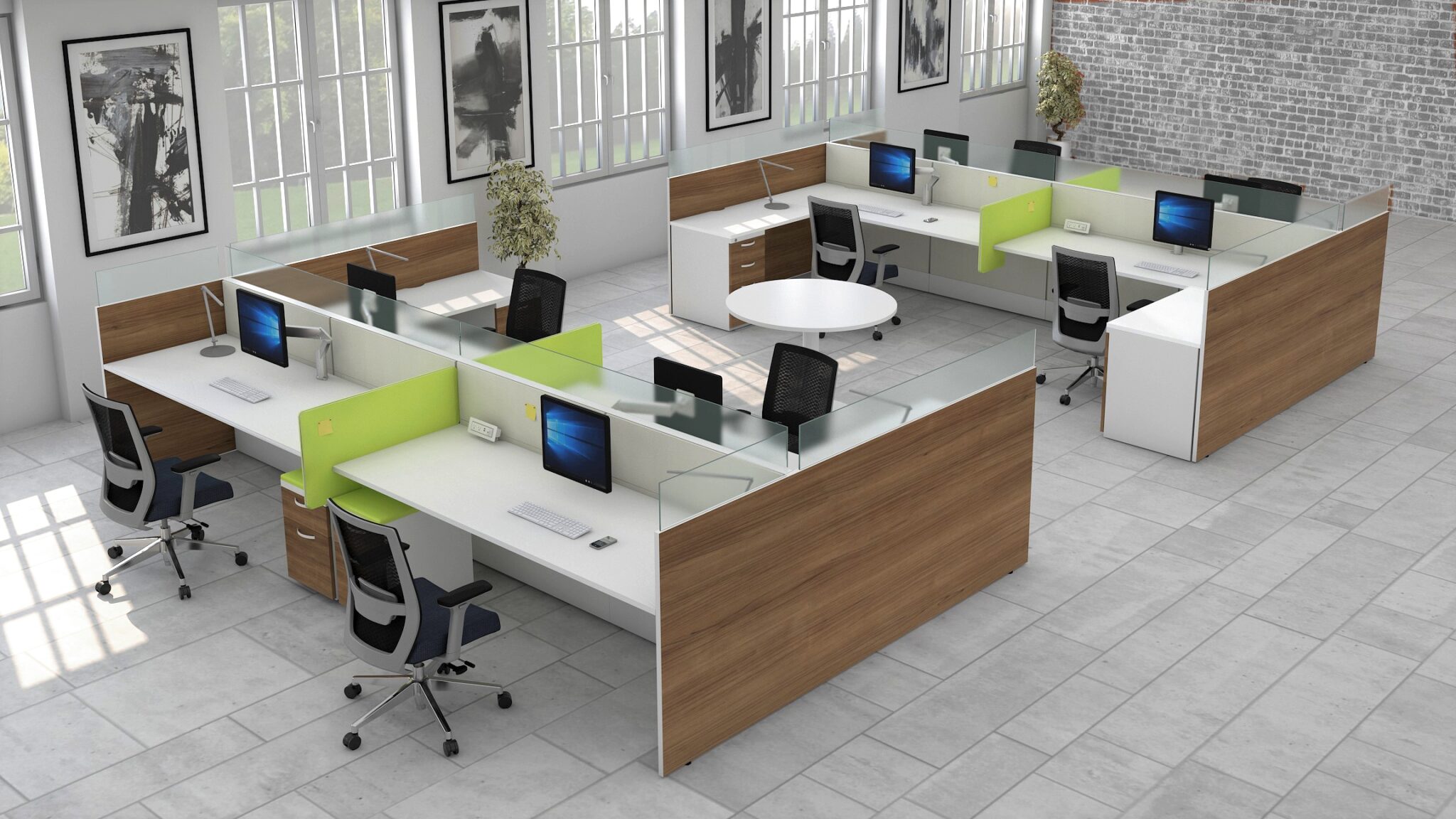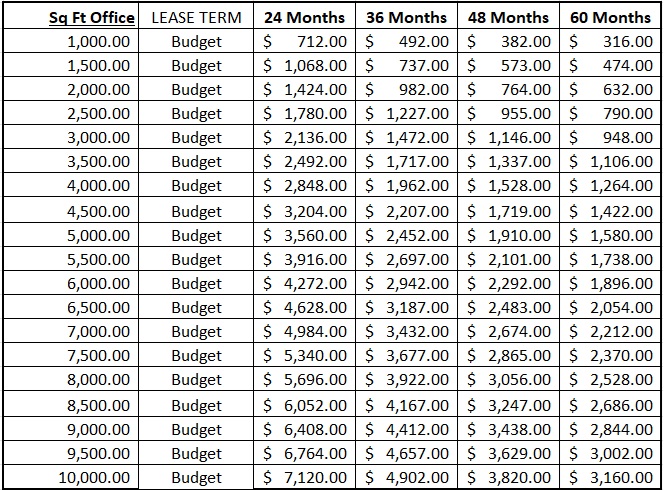Redefining Workspaces: The Comprehensive Guide to Hybrid Workplace Design in Chandler
Imagine a world where employees have the freedom to choose their ideal work environment, blending the best of both remote and in-office settings. This isn’t a distant dream; it’s the reality of the hybrid workplace model. According to a recent study, over 70% of global businesses have adopted some form of hybrid work, recognizing its potential to boost productivity and enhance employee satisfaction.
Chandler, Arizona, with its booming economy and diverse business landscape, is no exception to this trend. Known for its robust tech industry, vibrant start-up scene, and growing corporate presence, Chandler is rapidly becoming a hotspot for innovative work models. As businesses in Chandler continue to expand, the need for flexible and adaptive workspaces becomes increasingly crucial.
This comprehensive guide is designed to help Chandler-based businesses navigate the complexities of hybrid workplace design. From understanding the fundamentals of the hybrid model to implementing effective policies and optimizing physical and digital workspaces, this guide covers it all. Our goal is to provide you with actionable insights and practical tips to create a hybrid workplace that not only meets the needs of your business but also fosters a productive and engaging work environment.
Understanding the Hybrid Workplace Model
A hybrid workplace is a flexible work arrangement that combines remote work with traditional in-office work. This model allows employees to split their time between working from home or another remote location and being physically present in the office. The hybrid approach offers a dynamic and adaptable work environment, catering to the diverse needs and preferences of the modern workforce. It provides employees with the autonomy to choose where they work best while ensuring that essential in-person collaboration and team-building activities are not compromised.
The benefits of a hybrid workplace are numerous and impactful. One of the most significant advantages is the flexibility it offers. Employees can tailor their work schedules to fit their personal lives, which can lead to higher job satisfaction and a better work-life balance. This flexibility can also increase productivity, as employees can work during their peak hours in environments that suit their individual needs. Additionally, hybrid workplaces can attract and retain top talent by offering a more desirable work arrangement, reducing turnover rates, and enhancing employee morale. Furthermore, businesses can save on operational costs by reducing the need for large office spaces and associated expenses.
Despite its many advantages, the hybrid workplace model also presents several challenges. Communication can be a major hurdle, as teams must navigate the complexities of coordinating between remote and in-office employees. Ensuring that everyone remains informed and engaged requires robust communication tools and strategies. Additionally, maintaining a cohesive company culture can be difficult when employees are not physically present in the office together. Organizations must find innovative ways to foster a sense of community and belonging among their staff. Finally, managing remote work can lead to concerns about productivity and accountability, requiring businesses to implement clear policies and performance metrics to ensure that work is being completed efficiently and effectively.
Overall, while the hybrid workplace model offers significant benefits, it also demands careful planning and execution to address its challenges effectively. By understanding these dynamics, businesses in Chandler can create hybrid work environments that maximize productivity, satisfaction, and cohesion.

Stylish office chairs for businesses
The Business Landscape in Chandler
Chandler, Arizona, has experienced remarkable economic growth over the past decade, transforming into a vibrant hub for business and innovation. The city’s strategic location, favorable business environment, and robust infrastructure have attracted a diverse range of companies, fueling economic expansion. This growth has significantly impacted local businesses, fostering a dynamic and competitive marketplace that encourages innovation and collaboration. As a result, Chandler has become an attractive destination for entrepreneurs, startups, and established corporations looking to capitalize on its thriving economy.
Key industries in Chandler include technology, manufacturing, healthcare, and finance, each contributing to the city’s robust economic landscape. The technology sector, in particular, has seen substantial growth, with companies like Intel, Microchip Technology, and Infusionsoft establishing a strong presence in the area. The manufacturing industry also plays a crucial role, with businesses specializing in advanced manufacturing, aerospace, and automotive components. Healthcare and finance sectors have also flourished, providing essential services and employment opportunities to the local population. These industries not only drive economic growth but also create a diverse and resilient business environment.
Hybrid work models are especially beneficial for businesses in Chandler for several reasons. Firstly, the city’s tech-savvy workforce is well-equipped to adapt to remote work, leveraging advanced tools and technologies to stay connected and productive. Secondly, Chandler’s traffic congestion and commuting challenges make flexible work arrangements particularly appealing, allowing employees to avoid long commutes and work more efficiently. Additionally, the hybrid model supports Chandler’s diverse industries by offering tailored solutions that meet the unique needs of different sectors, from tech to healthcare. By adopting hybrid work models, businesses can enhance employee satisfaction, reduce operational costs, and remain competitive in an ever-evolving market.
In summary, Chandler’s economic growth, diverse industries, and tech-savvy workforce create an ideal environment for hybrid work models. By embracing this flexible approach, businesses in Chandler can capitalize on the city’s strengths, fostering innovation, productivity, and overall success.
Designing Your Hybrid Workspace
Designing an effective hybrid workspace requires thoughtful space planning to balance the needs of remote and in-office work environments. Proper space planning ensures that both physical office spaces and remote work setups are optimized for productivity and collaboration. In the office, this might involve creating flexible workstations, collaborative areas, and quiet zones that cater to various work styles and tasks. For remote work, it’s crucial to provide employees with the necessary tools and support to create efficient home office setups. Balancing these environments involves understanding the unique needs of your workforce and providing the infrastructure to support seamless transitions between remote and in-office work.
Optimizing physical office space for collaboration and productivity is essential in a hybrid work model. Consider incorporating open floor plans with modular furniture that can be easily reconfigured for different purposes, such as team meetings, individual work, or brainstorming sessions. Designate specific areas for collaborative activities, equipped with whiteboards, AV equipment, and comfortable seating to encourage teamwork and creativity. Additionally, creating quiet zones or private offices can help employees who need to focus or conduct confidential work. By designing a flexible and functional office space, businesses can foster a dynamic environment that supports both individual productivity and collaborative efforts.
Technology plays a pivotal role in the success of a hybrid workspace. Reliable and robust communication tools are essential to bridge the gap between remote and in-office employees. Platforms like Slack, Microsoft Teams, and Zoom facilitate real-time communication and collaboration, ensuring that all team members stay connected and engaged. Project management tools such as Trello, Asana, and Monday.com help streamline workflows, track progress, and manage tasks efficiently, regardless of location. Additionally, remote work tools like VPNs, cloud storage solutions, and cybersecurity measures ensure that employees can access and share information securely from anywhere. Leveraging the right technology is crucial to maintaining productivity and cohesion in a hybrid work environment.
Ergonomic considerations are vital for creating comfortable and efficient workspaces both at home and in the office. Investing in ergonomic furniture, such as adjustable chairs, sit-stand desks, and proper lighting, can significantly improve employee well-being and productivity. Encourage employees to set up their home offices with ergonomics in mind, providing guidelines on optimal desk setup, screen height, and posture. In the office, consider offering a variety of workstations that cater to different preferences, including standing desks, lounge areas, and traditional desks. By prioritizing ergonomics, businesses can help prevent work-related injuries and enhance overall comfort and efficiency for their employees.
In summary, designing a hybrid workspace involves careful planning and consideration of both physical and remote work environments. By optimizing office spaces for collaboration, leveraging technology for seamless communication and project management, and ensuring ergonomic setups, businesses can create a productive and engaging hybrid work model that meets the needs of their diverse workforce.
Creating a Hybrid Work Policy
Creating a comprehensive hybrid work policy is essential to ensure clarity, fairness, and productivity within an organization. The essential elements of a hybrid work policy include defining the eligibility criteria for remote work, outlining the expectations for in-office and remote workdays, and establishing guidelines for communication and collaboration. It should also address technology requirements, data security protocols, and ergonomic considerations for home offices. Additionally, the policy should specify performance metrics, regular check-ins, and methods for monitoring productivity and progress. Clearly delineating roles and responsibilities, as well as the process for requesting and approving remote work, helps set the foundation for a successful hybrid work model.
Ensuring fairness and consistency in hybrid work arrangements is crucial to maintaining employee morale and trust. To achieve this, organizations should apply the policy uniformly across all departments and roles, making exceptions only when absolutely necessary and justifiable. It’s important to consider various factors such as job responsibilities, individual performance, and team dynamics when determining remote work eligibility. Regularly reviewing and updating the policy based on feedback and changing business needs can also help maintain fairness. Additionally, providing training for managers on how to effectively oversee remote teams can ensure consistent application of the policy and equitable treatment of all employees.
Communicating the hybrid work policy to employees effectively is key to its successful implementation. Begin by clearly articulating the policy’s objectives and benefits, ensuring that employees understand the rationale behind it. Use multiple channels such as email, company intranet, and team meetings to disseminate the policy. Providing a detailed FAQ section can address common concerns and questions. It’s also important to create an open forum where employees can ask questions and provide feedback. Regularly collecting and reviewing employee feedback can help identify areas for improvement and demonstrate the organization’s commitment to continuous improvement and employee well-being. This two-way communication fosters transparency and helps employees feel valued and heard.
In summary, a well-crafted hybrid work policy is vital for the smooth operation of a hybrid work model. By outlining clear guidelines, ensuring fairness and consistency, and effectively communicating with employees, businesses can create a supportive and productive hybrid work environment that meets the needs of both the organization and its workforce.

Office cubicles with laminate panels and chairs
Measuring Success and Adapting
Measuring the success of your hybrid workplace design is crucial to ensure that it meets the goals of enhancing productivity, employee satisfaction, and operational efficiency. Without regular assessment, it’s challenging to understand the impact of your hybrid model and identify areas needing improvement. Evaluating the effectiveness of your hybrid workplace allows you to make data-driven decisions, justify investments in technology and infrastructure, and demonstrate the value of the hybrid model to stakeholders. By continuously measuring success, you can ensure that your hybrid workplace evolves to meet the changing needs of your employees and business.
Key performance indicators (KPIs) are essential tools for tracking the success of your hybrid workplace. Some important KPIs to consider include employee productivity, which can be measured by output metrics specific to each role or project completion rates. Employee engagement and satisfaction are also critical, and can be gauged through regular surveys, feedback forms, and retention rates. Monitoring the frequency and quality of communication and collaboration among team members can provide insights into the effectiveness of your hybrid work arrangements. Additionally, tracking the utilization of office space and remote work tools can help assess whether your resources are being used efficiently. These KPIs provide a comprehensive view of how well your hybrid workplace is functioning and highlight areas for improvement.
Adapting and improving your hybrid workplace over time requires a proactive approach to feedback and data analysis. Regularly soliciting feedback from employees through surveys, focus groups, and one-on-one meetings can provide valuable insights into their experiences and challenges. Analyzing this feedback alongside your KPIs helps identify trends and pinpoint specific issues. Based on this data, you can make informed adjustments to your policies, tools, and workspace design. For example, if employees report difficulties with communication, you might invest in better collaboration tools or provide additional training. Additionally, staying informed about industry best practices and emerging trends can inspire innovative solutions to enhance your hybrid work model. By remaining flexible and responsive to feedback, you can continuously refine your hybrid workplace to better support your employees and achieve your business goals.
In summary, measuring the success of your hybrid workplace design and adapting based on data and feedback are essential for maintaining a productive and satisfied workforce. By tracking key performance indicators and making informed adjustments, businesses can ensure their hybrid work models remain effective and responsive to the needs of their employees and the evolving business landscape.
Conclusion
In this comprehensive guide, we’ve explored the key aspects of hybrid workplace design, tailored to meet the unique needs of businesses in Chandler. We started by defining what a hybrid workplace is and discussing its numerous benefits, including flexibility, increased productivity, and enhanced employee satisfaction. We then delved into the economic landscape of Chandler, highlighting its diverse and thriving industries, and why hybrid work models are particularly advantageous for local businesses. We provided practical advice on designing hybrid workspaces, from optimizing office layouts to leveraging technology and ensuring ergonomic considerations. We also outlined the essential elements of a hybrid work policy and discussed the importance of measuring success and adapting based on feedback and data.
For businesses looking to implement or improve their hybrid workplace design, here are some actionable tips:
- Define clear policies: Establish eligibility criteria, expectations, and guidelines for remote and in-office work.
- Optimize office space: Create flexible, collaborative areas and quiet zones to support various work styles.
- Leverage technology: Use robust communication and project management tools to keep remote and in-office teams connected.
- Ensure ergonomics: Invest in ergonomic furniture and provide guidance for setting up comfortable home offices.
- Measure and adapt: Track key performance indicators and regularly gather employee feedback to make informed adjustments.
The future of work in Chandler is bright, with hybrid work models offering exciting opportunities for businesses and employees alike. Embracing the hybrid model can lead to a more dynamic, productive, and satisfied workforce, positioning Chandler as a leader in innovative work environments. By thoughtfully designing and continuously improving hybrid workplaces, businesses can thrive in this evolving landscape, fostering a culture of flexibility, collaboration, and growth.
In closing, we encourage Chandler-based businesses to embrace the hybrid work model and capitalize on its numerous benefits. With careful planning and a commitment to continuous improvement, the hybrid workplace can be a powerful tool for success in the modern business world.

Office chair buying guide
Ready to transform your Southeast Valley workspace and create an environment that fosters creativity, collaboration, and productivity?
Contact Interior Avenue today for a free consultation! Our team of experts will guide you through the process of selecting the perfect furniture to elevate your office and propel your Southeast Valley business to new heights.
As you consider the needs of your office, both now and in the years to come, Interior Avenue represents a strategic partner capable of supporting your journey towards creating an ideal workspace. Whether you’re a startup looking to make a mark, a growing business planning to expand, or simply in need of refreshing your current office setup, Interior Avenue offers the solutions to meet your needs efficiently and stylishly. Let Interior Avenue be your guide to a more adaptable, affordable, and aspirational office environment in the heart of the Phoenix Southeast Valley.
For those looking for swift solutions without compromising on quality or budget, consider partnering with Interior Avenue. Renowned for their fast service and affordable options, they provide an array of office furniture tailored to modern business needs. We hope this guide offers clarity and guidance in your office furniture procurement process. Making the right choice can lead to a vibrant, efficient, and comfortable workspace, promoting well-being and productivity among employees.

Office furniture subscription monthly model budget
We have 3 options to buy:
Purchase upfront– Pay upfront for your office furniture to be delivered and installed.
Rent to own– We help you break up the payments to help with cash flow. This service includes delivery and installation.
Subscription rental– Monthly payments that include delivery and installation and when your subscription is over we will take back the furniture and move it out of your office space for free.
https://interioravenue.net/mastering-the-art-of-selecting-cubicles-in-chandler-a-detailed-exploration/





Leave a reply